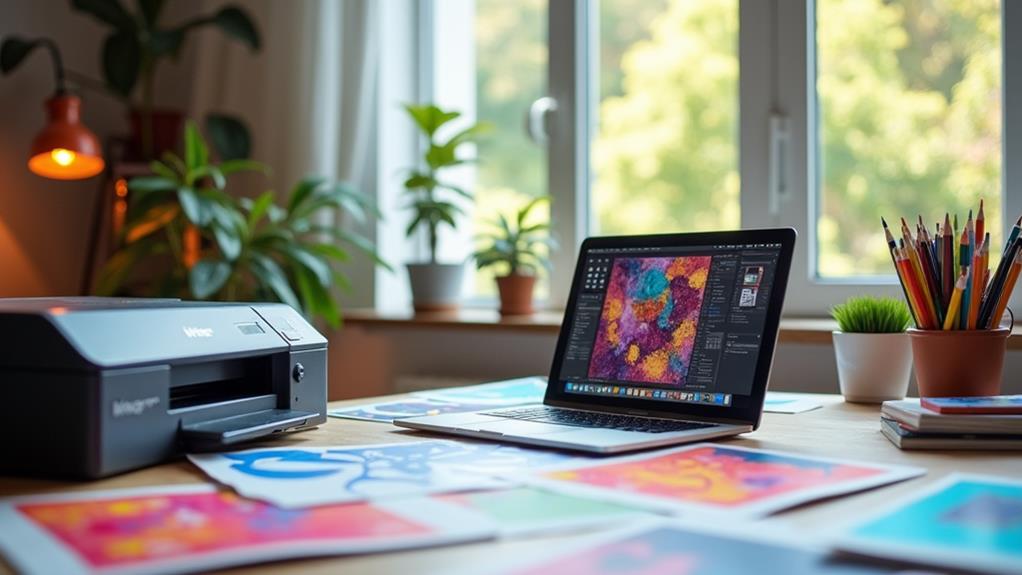
For creating exquisite print on demand designs, Adobe Photoshop and Illustrator are industry standards, offering advanced tools for both raster and vector graphics. Photoshop excels in photo manipulation with features like layers and masks, while Illustrator provides unparalleled vector scalability. Alternatives like GIMP and Inkscape are excellent open-source options, with robust features and support for multiple file formats. Affinity Designer serves as a cost-effective replacement with an intuitive interface. Web-based platforms like Canva and Placeit simplify design processes for users at all levels. To discover how these tools cater to various design needs and workflows, continue exploring.
Key Takeaways
- Adobe Illustrator excels in creating scalable vector graphics, ensuring high-quality prints at any size.
- Photoshop offers advanced photo editing tools, ideal for detailed pixel-based designs.
- Canva provides an intuitive interface with extensive templates, perfect for beginners and professionals alike.
- Inkscape is a powerful, free vector graphics editor, offering advanced tools suitable for intricate design work.
- Affinity Designer offers a cost-effective alternative to Illustrator with a user-friendly interface and robust features.
Photoshop
Harnessing the power of Photoshop can be a game-changer for designers delving into the print on demand industry. As a pixel-based software, Photoshop excels in photo editing and pixel manipulation, making it ideal for crafting intricate designs. Its robust support for various file formats like JPEG and PNG guarantees that high-quality images are prepared for print applications with remarkable precision.
Advanced features such as layers, masks, and filters empower designers to create complex compositions and stunning effects, bringing their print designs to life.
Customized product images greatly enhance brand perception and customer engagement, which can be easily achieved using Photoshop's advanced tools. Utilizing Photoshop shortcuts, designers can greatly enhance their workflow efficiency, enabling quick adjustments and seamless navigation through the software's extensive toolset.
Photoshop templates designed for specific print applications further streamline the design process. These templates guarantee proper dimensions and resolutions, crucial for producing high-quality prints.
Although the learning curve for mastering Photoshop can be steep, the abundance of online courses and tutorials available can expedite the learning process. This makes Photoshop an accessible tool for both beginners and seasoned designers aiming to boost their print on demand creations.
Illustrator
While Photoshop offers unparalleled capabilities for photo editing and pixel-based designs, Adobe Illustrator stands out as the premier choice for vector-based creations. This distinction is essential for users focused on print on demand products, where design scalability is of paramount importance.
Vector graphics, unlike raster images, maintain their quality regardless of size, ensuring that designs look crisp on anything from a small sticker to a large banner.
Adobe Illustrator provides an extensive suite of advanced tools tailored for typography, shapes, and color management. These features empower designers to craft intricate and highly customizable designs.
The software's support for multiple file formats, including .ai and .eps, aligns with industry standards, ensuring high-quality print outputs. Additionally, Illustrator's robust library of tutorials and learning resources makes it accessible for beginners while offering opportunities for experienced users to refine their skills.
For those looking to create custom products, Illustrator's capabilities can be a game changer. The familiarity of Illustrator's interface for Photoshop users further eases the shift, allowing them to leverage their existing skills while expanding their capabilities in vector graphics.
GIMP
GIMP
GIMP, or GNU Image Manipulation Program, is a robust, free, and open-source raster graphics editor that has carved out a notable niche among budget-conscious print on demand creators. Known for its versatility, GIMP supports a myriad of file formats such as JPEG, PNG, and GIF, making it a flexible tool for diverse design requirements. GIMP customizations, including custom brushes, layers, and filters, offer designers extensive creative control over their projects.
With minimal equipment and a low financial barrier, GIMP is accessible for beginners looking to refine their skills.
However, GIMP user feedback often highlights a steep learning curve due to its complex interface, which can be intimidating compared to more intuitive platforms like Canva or Photopea. Fortunately, GIMP community support is extensive, providing a wealth of GIMP tutorial resources that can help new users master the software's capabilities.
Effective GIMP layer management and advanced GIMP design techniques are pivotal when creating high-resolution images for print on demand. Users must also be meticulous with GIMP export settings, particularly DPI adjustments, to guarantee ideal print quality.
GIMP performance tips, like optimizing workspace layouts and utilizing keyboard shortcuts, can greatly enhance workflow efficiency. Ultimately, GIMP's powerful features and strong community support make it an invaluable asset for dedicated designers.
Inkscape
For those seeking a robust alternative to raster graphics editors like GIMP, Inkscape presents an exceptional choice as a free, open-source vector graphics editor. Inkscape stands out for its ability to create scalable designs that maintain quality at any size, which is a critical requirement for print on demand applications. This capability guarantees that your designs look crisp and professional, whether they're printed on a small mug or a large poster.
Additionally, leveraging unique brand elements like custom shapes and logos can further enhance the distinctiveness of your merchandise.
Inkscape supports a variety of file formats such as SVG, AI, and PDF, facilitating seamless integration with other design tools and print services. This compatibility is particularly beneficial for designers who collaborate across different platforms or need to ascertain their designs meet specific printing criteria.
The software's advanced drawing tools, including bezier curves and custom shapes, provide the flexibility to craft intricate designs tailored for merchandise. These features, combined with the cost-effectiveness of Inkscape, make it a formidable competitor to paid vector design software like Adobe Illustrator.
Moreover, the Inkscape community is a valuable resource, offering a wealth of Inkscape tutorials and shared experiences that greatly aid beginners. This collaborative environment not only accelerates the learning curve but also fosters continuous improvement and innovation among users.
Affinity Designer
Harnessing the power of a cost-effective yet robust vector graphics software, Affinity Designer emerges as a compelling alternative to Adobe Illustrator for creating scalable designs.
One of the major Affinity Designer advantages is its support for a wide array of file formats, including .svg, .ai, and .eps, making it exceptionally versatile for print on demand projects. This versatility guarantees seamless integration with various printing services and other design software, providing a smooth workflow for designers. Additionally, Affinity Designer's data-driven visuals can greatly boost engagement and brand recall when implemented effectively.
Affinity Designer's one-time purchase model eliminates recurring subscription fees, offering considerable cost savings for freelance designers and small businesses. The software's user-friendly interface allows for intuitive navigation and swift access to essential tools, enabling designers to create professional-grade designs efficiently. This ease of use is further enhanced by a wealth of Affinity Designer tutorials available online, which cater to both novice and seasoned users.
Advanced features such as real-time performance, unlimited artboards, and a thorough asset management system make Affinity Designer a powerful tool for complex design tasks.
These capabilities guarantee that whether you're designing intricate graphics or managing extensive design projects, Affinity Designer delivers high performance and productivity.
Canva
Building on the strengths of Affinity Designer, another formidable tool in the print on demand design arsenal is Canva. This web-based design platform excels in accessibility and functionality, making it an ideal choice for both novice and seasoned designers.
One of the standout Canva features is its extensive library of free templates, meticulously tailored for print on demand products. Whether designing t-shirts, mugs, or posters, these Canva templates provide a professional starting point, ensuring high-quality results even without prior graphic design experience.
Moreover, the platform supports high-resolution downloads, which is vital for maintaining print quality. This attention to detail is essential for creating compelling designs that resonate with the audience.
The platform's intuitive drag-and-drop interface additionally simplifies the design process. Users can effortlessly customize elements such as text, images, and colors to align with their brand identity.
Additionally, Canva supports high-resolution downloads, a significant aspect for maintaining quality in printed products.
For those seeking more advanced capabilities, the Canva Pro version reveals premium templates, advanced editing tools, and even social media scheduling.
Another notable Canva feature is its collaborative functionality, allowing teams to work on designs in real-time, thereby streamlining the design workflow for businesses.
Placeit
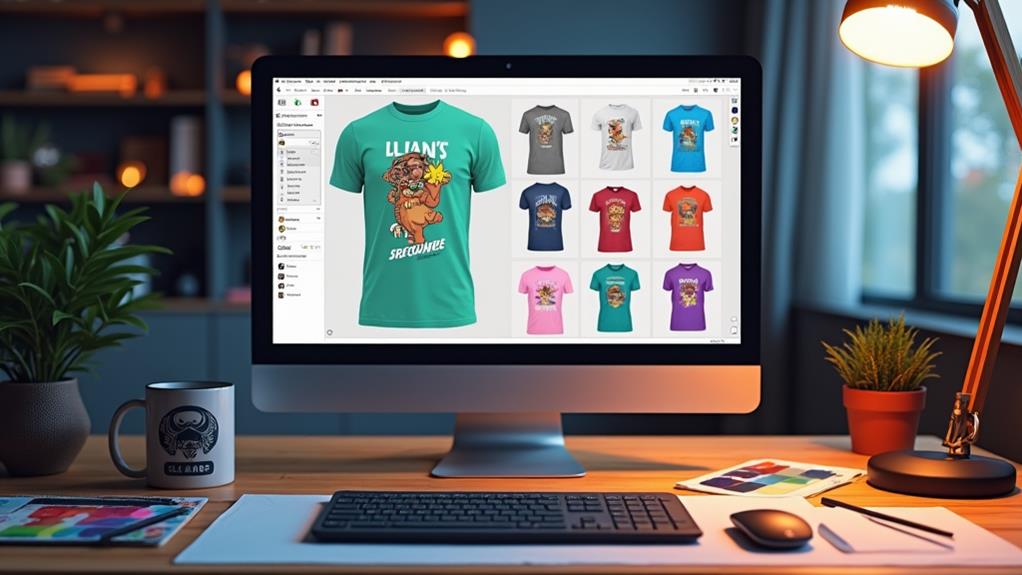
Innovation meets efficiency in Placeit, a versatile platform offering an extensive array of design templates and mockups specifically tailored for print on demand ventures.
With a library exceeding 97,000 templates and mockups for various product categories, users can seamlessly create professional-grade designs. The platform's design tool, akin to Canva, features over 10,000 customizable templates, enabling effortless template customization to suit individual needs. This makes it a perfect tool for selling design templates and generating passive income.
Placeit's robust suite of features includes a Logo Creator, designed to streamline branding strategies. This tool allows users to generate unique logos quickly, accommodating a wide range of business requirements. The ease of creating distinct branding elements on Placeit can greatly enhance the visual identity of print on demand products.
Additionally, Placeit incorporates a Video Maker feature, empowering users to craft animations and engaging social media content. This capability is invaluable for marketing efforts, providing dynamic visual content to attract and retain customer interest.
The subscription model offers cost-effective access to Placeit's extensive library of resources and templates, making it an ideal choice for entrepreneurs and small businesses looking to optimize their design processes.
Photopea
Photopea, a free web-based photo editing tool, offers robust compatibility with various file formats including PSD, making it a versatile alternative to Photoshop.
Its user-friendly interface supports both raster and vector graphics, allowing for intricate designs with transparent backgrounds, essential for high-quality print on demand products.
Regular updates guarantee Photopea remains aligned with current design trends, positioning it as a reliable and accessible option for designers.
For those interested in creating personalized gifts, Photopea's customization features make it an excellent choice.
Photopea Key Features
How does one find a versatile yet user-friendly photo editing tool that rivals the capabilities of premium software? Photopea features an impressive array of tools that cater to both novice and professional designers, making it an excellent choice for creating print on demand designs.
As a web-based application, Photopea eliminates the need for installation, ensuring compatibility with any computer configuration. This accessibility is one of the significant Photopea advantages, as users can work on their projects from any device with an internet connection.
Among the standout Photopea features is its support for both raster and vector graphics, allowing for a broad spectrum of design possibilities. Users can open and edit various file formats, including PSD, Sketch, and XCF, facilitating seamless integration with other design software.
The user-friendly interface offers advanced functionalities such as layers, masks, and blending modes, essential for crafting intricate designs.
Photopea's capabilities extend to basic image adjustments like brightness and contrast, as well as sophisticated design tools needed for high-quality print products.
This blend of accessibility, versatility, and powerful features positions Photopea as a formidable alternative to more costly photo editing software, ideal for print on demand needs.
Photopea vs. Photoshop**
When choosing between Photopea and Photoshop for print on demand designs, several key differences and similarities emerge that can guide your decision.
Photopea is a free, web-based photo editing tool that mirrors many functionalities of Adobe Photoshop, making it an attractive option for budget-conscious designers. One of the primary Photopea advantages is its accessibility; it operates directly in a web browser, requiring no installation and supporting various file formats like PSD, XCF, and Sketch.
In contrast, Photoshop necessitates a subscription, which can be a significant investment for some users. While Photoshop is renowned for its extensive toolset and professional-grade capabilities, it also has limitations that may not justify the cost for everyone.
Here's a breakdown to evaluate:
- Cost Efficiency: Photopea offers a free solution without compromising on essential editing features, unlike Photoshop's subscription model.
- Accessibility: Photopea's web-based nature allows it to run on any computer configuration, bypassing the need for specific hardware or software installations.
- User-Friendliness: Both platforms support advanced editing tasks like layer manipulation and blending modes, but Photopea's interface is particularly noted for its ease of use, making it ideal for quick, on-the-go adjustments.
DesignBundles
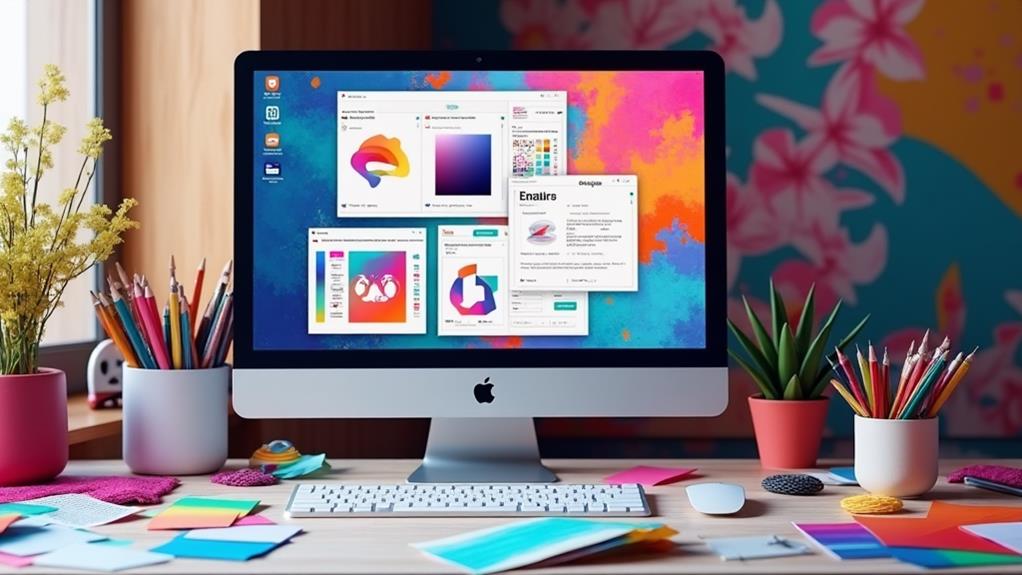
DesignBundles stands out as a premier resource for anyone involved in print-on-demand projects, offering a meticulously curated collection of high-quality images and design resources designed for commercial use. This platform's extensive library includes graphics, illustrations, and templates that cater to diverse creative needs, ensuring users can personalize and enhance their designs without copyright concerns.
The benefits of using DesignBundles are manifold. Users can leverage both free and premium resources, accommodating various budget constraints while expanding their creative possibilities. The platform's continuous updates and promotions keep the community abreast of the latest design trends and tools, an invaluable asset for maintaining relevancy in a competitive market.
Moreover, the DesignBundles community thrives on collaboration. Designers are encouraged to share their work, fostering an environment where members can learn from each other and uplift their craft collectively. This collaborative spirit not only enhances individual projects but also enriches the community as a whole.
| Feature | Description |
|---|---|
| High-Quality Images | Curated for commercial use, ensuring copyright compliance. |
| Diverse Range | Graphics, illustrations, and templates for various needs. |
| Free and Premium | Resources available for different budgetary requirements. |
| Community Engagement | Collaborative environment with opportunities for sharing work. |
Vecteezy
While DesignBundles offers a treasure trove of high-quality images and collaborative opportunities for print-on-demand designers, Vecteezy emerges as another indispensable resource in this creative landscape. Vecteezy is a community-driven platform that boasts an extensive library of customizable vector graphics and illustrations, catering to a wide array of design needs.
This platform addresses the demand for both free and premium content, providing users with access to high-quality designs while fostering a collaborative environment among designers. The platform's user-friendly search function allows for seamless navigation, enabling users to find specific graphics efficiently. Additionally, Vecteezy supports continuous skill development by offering resources that help designers stay competitive in the market.
One of the standout features of Vecteezy is its user-friendly search function, which allows designers to quickly find specific graphics based on categories or keywords. This feature guarantees that users can efficiently locate the exact vector graphics they need for their projects.
The Vecteezy community thrives on user engagement, encouraging designers to upload their work and thereby enhancing the diversity of available resources. This collaborative approach not only enriches the platform's offerings but also promotes a vibrant, supportive environment for creative professionals.
Key Advantages of Vecteezy:
- Extensive Library: Vast collection of vector graphics and illustrations.
- Flexible Licensing: Many resources available for personal and commercial use.
- Collaborative Community: Designers can share and discover diverse works.
Vecteezy is an essential tool for designers seeking versatile and reliable vector graphics.
Stock Image Resources
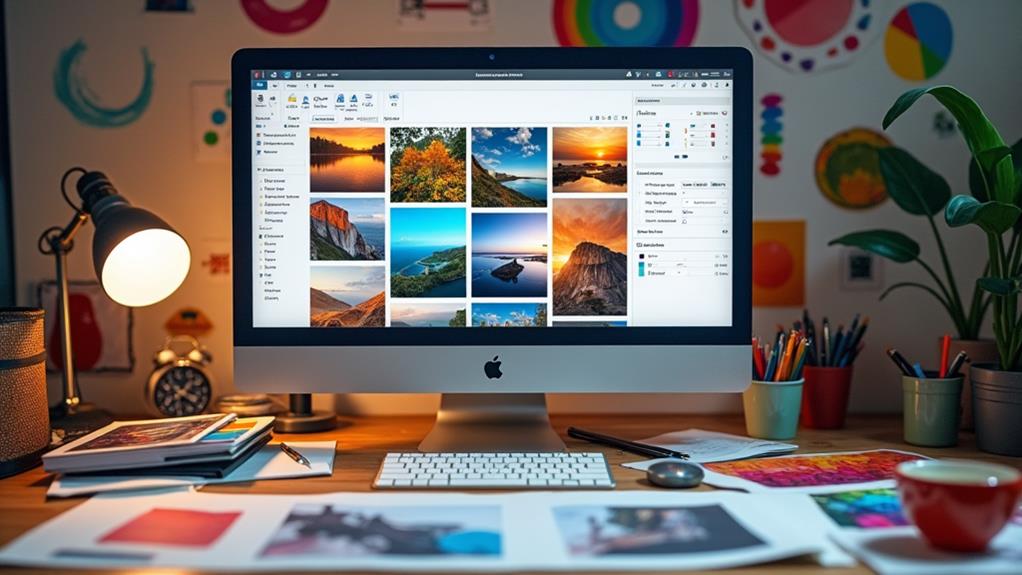
Maneuvering through the world of stock image resources can be overwhelming, but understanding the unique offerings of various platforms can greatly enhance a designer's toolkit. StockVault stands out with its diverse range of free images, though it's crucial to note that commercial use requires alterations, and the sale or transfer of original designs is prohibited. Pexels simplifies the search for high-quality photos through the use of hashtags, providing free downloads, but demanding edits for commercial applications.
For those seeking categorized stock images, Free Stocks is an excellent resource, offering free downloads with the flexibility to modify images for personal use; however, resale of downloaded photos is not allowed. Unsplash is renowned for its extensive collection of high-quality images, suitable for various designs, with free downloads available and no attribution required. Meanwhile, Pixabay boasts a vast collection of free images, videos, and music available for commercial use without attribution, making it user-friendly for designers seeking diverse resources.
| Platform | Key Features |
|---|---|
| StockVault | Free images, alterations required for commercial use |
| Pexels | High-quality photos, hashtag search, edits needed for commercial use |
| Free Stocks | Categorized images, free download, no resale |
| Unsplash | Extensive high-quality images, no attribution required |
| Pixabay | Free images, videos, music, commercial use without attribution |
Understanding image licensing and stock photo quality across these platforms guarantees that designers can make informed decisions to enhance their print-on-demand designs.
User Experiences
User experiences with various software tools reveal distinct advantages and challenges, particularly with GIMP and Inkscape.
While GIMP's free availability positions it as a notable alternative to Photoshop, users often encounter steep learning curves that impact its usability.
Conversely, Inkscape garners acclaim for its cost-effectiveness and robust vector design capabilities, making it a favored choice among budget-conscious designers.
Additionally, Canva offers a user-friendly interface for quick, quality designs, making it popular among those who need rapid results without extensive training.
GIMP Usability Challenges
Steering through the complexities of GIMP has proven to be a formidable challenge for many users, as evidenced by the mixed reviews surrounding its usability. User feedback frequently highlights the steep learning curve associated with GIMP, which can be discouraging for beginners trying to fully harness its extensive capabilities.
The interface, often described as less intuitive than competitors like Canva or Photopea, adds another layer of difficulty for those new to graphic design. Despite its robust functionality and free accessibility, GIMP's design can be overwhelming, with many users struggling to focus on essential tasks for creating print on demand designs.
The following points summarize the core usability challenges:
- Complex Interface: The intricate layout and numerous features can be intimidating, making it difficult for users to navigate and locate necessary tools efficiently.
- Steep Learning Curve: The abundance of features requires significant time investment in learning resources, which can be off-putting for beginners.
- User Frustration: Community feedback often mentions frustration due to the less intuitive design, especially when shifting from more user-friendly platforms.
Inkscape Cost-Effectiveness**
Inkscape frequently emerges as a highly cost-effective solution among design software options, particularly appreciated by users on a budget. As a free, vector-based design software, Inkscape offers an effective alternative to premium tools like Illustrator, without sacrificing quality or functionality.
Users have lauded Inkscape features, which include an extensive toolset capable of producing scalable and high-quality graphics suitable for print on demand. This makes it an attractive option for small businesses and independent designers who aim to minimize expenses while maintaining industry standards.
One of the standout aspects of Inkscape is its support for a variety of file formats, including SVG, which is particularly advantageous for creating print-ready designs. This flexibility guarantees that users can seamlessly integrate their creations into various print on demand platforms.
Community feedback consistently underscores the software's cost-effectiveness, emphasizing its role in democratizing design capabilities. Additionally, Inkscape tutorials available online further enhance its accessibility, providing step-by-step guidance to help users maximize the software's potential.
This combination of zero cost, robust Inkscape features, and extensive tutorials makes Inkscape a compelling choice for budget-conscious designers seeking professional results.
File Formats and Compatibility
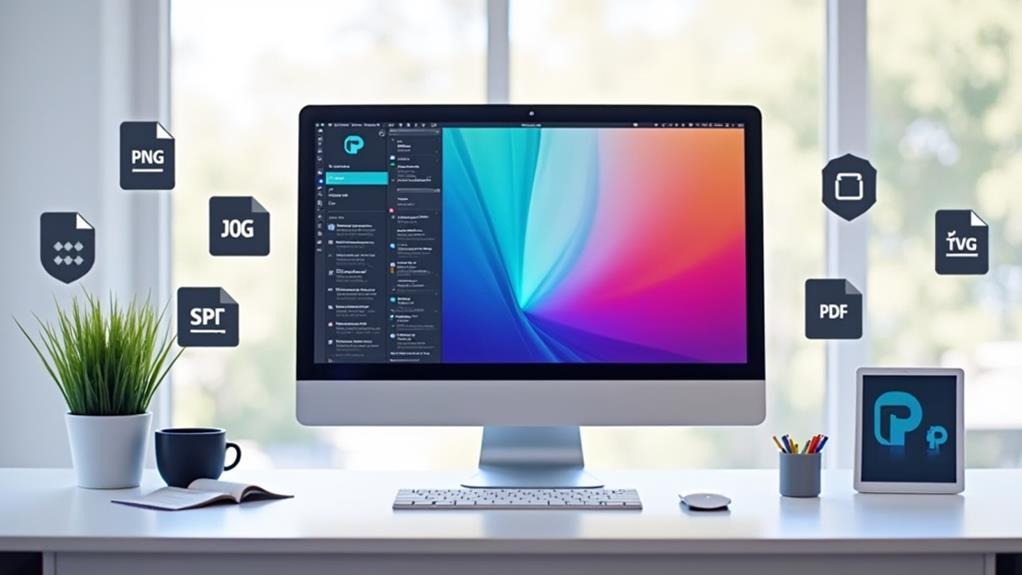
When designing for print on demand, understanding file formats and compatibility is vital to achieving high-quality results. Different file formats offer unique advantages and limitations that impact design scalability and print quality.
Vector files, such as .ai and .eps, stand out for their ability to be resized without losing quality, making them perfect for scalable print on demand designs. On the other hand, raster formats like JPEG and PNG are widely used but must meet high resolution requirements to avoid pixelation issues.
To guarantee ideal print quality, adhering to DPI standards is essential. A minimum of 300 DPI is recommended for design files to maintain sharpness and detail across various products.
Additionally, using the CMYK color model is necessary for print designs, as it guarantees accurate color reproduction in the final printed product. Incorporating bleed settings in your design files provides a safety margin, preventing key elements from being cut off during the printing process.
Here are three significant considerations:
- File Format Differences: Vector vs. raster and their respective advantages and limitations.
- Resolution Requirements: Confirming designs meet the 300 DPI standard.
- Color Models and Bleed Settings: Using CMYK and including bleed areas for precise prints.
Frequently Asked Questions
Which Software Would You Use to Create a Print Design?
For creating a print design, I would use Affinity Designer. This graphic software offers robust vector design tools, making it ideal for high-quality, scalable print designs. Its cost-effectiveness and professional-grade features make it an excellent choice.
How Do I Make Prints on Demand Art?
To create print on demand art, apply design techniques like vectorization and high-resolution imaging. Experiment with diverse art styles to enhance visual appeal. Guarantee designs are at 300 DPI and adhere to product-specific dimensions and bleed settings.
Can I Use Designs From Canva for Print-On-Demand?
Yes, you can use Canva designs for print-on-demand, but guarantee compliance with Canva licensing terms. Design customization is essential; export high-resolution formats and adhere to size specifications for best quality and professional results.
What Is Print-On-Demand Software?
Print-on-demand software refers to digital platforms providing design tools and customization options, enabling users to create personalized products. These systems automate manufacturing and fulfillment, integrating seamlessly with e-commerce sites for efficient order processing and inventory management.
Conclusion
In conclusion, several software options excel in creating print on demand designs, each with unique strengths. Adobe's Photoshop and Illustrator offer robust capabilities for raster and vector graphics, respectively. GIMP and Inkscape present cost-effective alternatives with substantial functionality. Affinity Designer merges features of the Adobe suite at a competitive price. Vecteezy provides ease of use for beginners. Supplementing these tools with stock image resources further enhances design potential. Compatibility with various file formats guarantees seamless integration into print workflows.
Leave a Reply